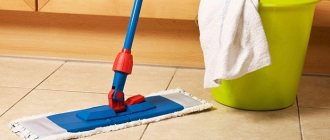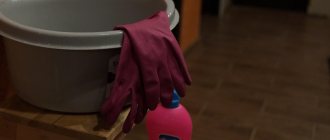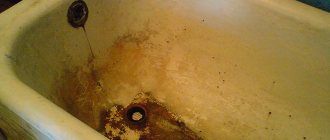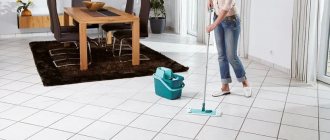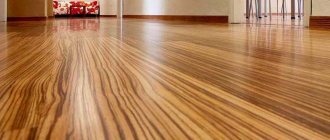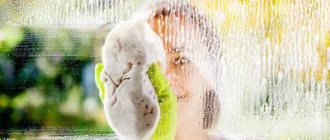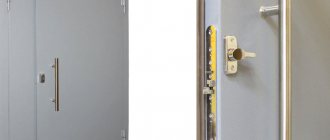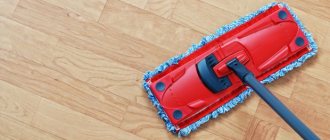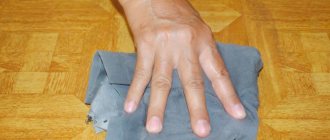How to choose products for washing and cleaning linoleum
To select chemicals for washing and cleaning, you need to remember what the protective film of linoleum is made of. Vinyl chloride, vinyl, PVC coating does not like acids and reacts normally to alkaline agents. Natural linoleum, on the contrary, does not tolerate alkalis well and can be in contact with acids for a long time. When choosing cleaning products, remember this point.
“Does not like” does not mean that some product cannot be used. Almost everything can be used for all types of coatings. It’s just that it’s better not to leave those that the coating “doesn’t like” on the surface for a long time, and after removing, wash off the residue with water, and then wipe dry with a well-absorbing cloth or paper.
Not all products can be used to clean linoleum. Some of them may damage the coating
What chemicals to use for cleaning linoleum? If you try, you can find products for this particular coating in stores. But there are not many of them and there are no objective reviews about their use. Usually they try to remove stains or wash with what they have at hand at home. And these are products for the kitchen, toilet and laundry. In principle, you can carefully try everything that is in your home arsenal. Gently - this is in a small space and not for long, then thoroughly clean and wash the treated area with plenty of water. If there is a result, but there are no changes in the condition of the linoleum (it has not become rougher or stickier), you can continue to clean it with the same product.
You can also recommend trying auto chemical products. That part of it that is for cleaning the interior and/or plastic parts. These products were developed to remove complex contaminants that are almost inevitable in a car. They often give very good results: they help clean linoleum where other means have failed.
What can't be used?
Linoleum is quite easy to maintain, but there are recommendations to extend its service life. When washing linoleum, regardless of its type, it is undesirable to use:
- baking soda: the composition contains alkali, which makes the top protective layer brittle and damages it.
- laundry soap: leaves streaks and is difficult to wash off;
- vinegar, since acids have a negative effect on the surface;
- citric acid, which causes the design to fade;
- bleaches, bleach - aggressive chemicals spoil the color, reduce brightness, and destroy the top layer. With frequent use, the coating is destroyed to the ground.
- abrasive powders that leave scratches and streaks.
What absolutely cannot be used to wash dirt off linoleum?
It has already been said above that a number of compositions and solutions cannot be used to clean linoleum. They can cause irreparable damage to the coating. When washing linoleum, you should avoid:
- mixtures prepared on the basis of alkalis and soda - they make the coating brittle. They can be used extremely rarely, in small areas and only in case of special contamination that other means simply cannot cope with;
- solvents and bleaches - they not only destroy the structure of the coating, but also destroy its brightness;
- abrasive brushes are dangerous because under their influence a certain number of microcracks can form in the coating;
- chlorine-containing compounds - spoil the appearance of the material.
Advice! You can try an unfamiliar linoleum cleaning product in an inconspicuous corner of the room. If there is no negative reaction of the coating to the impact, then all floors can be washed with the product.
How to clean linoleum after repair
Usually, after repairs, even cosmetic ones, the condition of the floor covering becomes deplorable. Construction mixtures, glue, whitewash, paints. All this is eaten away and very difficult to remove. Moreover, many substances act as abrasives, scratching the protective film of linoleum. This significantly reduces its service life and worsens its appearance. Damage to the protective film is what causes permanent stains to appear. Through damage, various coloring substances penetrate inside, and it is almost impossible to remove them from there - only together with the design. So you can wash linoleum and remove stains from it only if the protective coating is intact.
After repairs, there are many different stains left, and even dust that hangs in the air
So that there are no problems
Before repairing, it is best to lay linoleum. Film, tarpaulin, covering material. It doesn't matter what. It is important to protect against scratches and stubborn stains. Spread the selected material and secure it to the baseboards with double-sided tape - this will save you from lengthy cleaning after repairs and preserve your linoleum.
To avoid stains on linoleum after repairs
If the advice is late and the stains are already present, we try to clean the linoleum from ingrained construction dirt. The stains after repair remain very different and you have to select products for each separately. So it takes a long time and, often, not cheap.
Removing a paint stain
We fight water-based emulsion and whitewash stains in the same way. First, we dry remove what we get, then fill the stain with water and let it sit. The residue becomes softer and can be rubbed off with a kitchen sponge. We collect everything that has been washed using a rag or paper towel. Wipe with water, to which you can add a little dishwashing detergent or liquid soap. To remove traces of whitewash from linoleum, you can add vinegar to the water (no more than 200 ml per bucket of water).
You can remove enamel from linoleum using nail polish remover without acetone . There is one, just find an unpainted one. Apply the liquid to the swab and rub the stain. Change the tampon as it becomes dirty, otherwise the stain may increase in size, although it will become lighter.
Few people know how to work without leaving traces
It is easy to remove wood varnish from linoleum if it has not yet dried. The varnish is removed with ordinary damp wipes. If the stains are dried, we try solvents: purified gasoline, white spirit, alcohol, vodka; acetone or nail polish remover can help.
Before using solvents to remove stains from linoleum, test in an inconspicuous area or on a remaining piece. An inconspicuous place - behind a closet, under a sofa or bed. Remove the product, wipe with a damp cloth a couple of times, and wipe dry. Did it help or not? Has the protective layer corroded? Be careful, otherwise the mixture may turn out to be such that the linoleum will need to be replaced.
The only thing that is almost impossible to wash off is stain from linoleum. Especially if it is unwashable. It even penetrates through the protective coating. So far no methods have been invented to combat this.
How to get rid of traces of building mixtures
The primer is difficult to wash off as it contains glue. It can be removed by rubbing for a long time with the hard side of a kitchen sponge. You can wash off the primer from linoleum much faster with glass washing liquid - it helps a lot. There is another option on how to remove a primer stain on linoleum - dilute acetone with water (1 part acetone, 2 parts water) and rub with a sponge, but be careful with acetone . It will quickly dissolve some polymers. Faster than a blur.
Construction mixtures should “stick” well. And they stick to the floor too
Is it possible to wash plaster and putty from linoleum? Can. Removing the plaster itself is usually easy. The problem is that the main part of the composition has been removed, and a whitish mark remains on the linoleum. These traces are washed away over time, but you don’t always want to wait. Getting rid of them is easy - traces of gypsum and lime plaster and putty can be easily removed with water and vinegar.
Although silicone is not a building mixture, if it spills, you will have to try to get rid of it. It spreads in a very thin layer, making the floor very slippery. It is not possible to remove silicone grease from linoleum with solvents. But purified gasoline, turpentine or white spirit can help.
We remove adhesives: super glue, wallpaper glue, tape
Oddly enough, you can remove super glue from linoleum using dimexide. This inexpensive medicine is sold at the pharmacy. It has a characteristic odor and leaves an oily residue on the skin. Dip a swab or piece of rag and rub the spilled super glue. We also fight with Moment glue.
Dimexide is an almost magical product that removes glue, paint, varnish and even polyurethane foam
It is also not easy to remove wallpaper glue from linoleum. Sticky spots remain, reminiscent of tape marks. Dirt also sticks to them, so they become sticky and black. In general, we wash stains from wallpaper glue with purified gasoline or kerosene. For some types of glue, vinegar and window cleaner will work.
After prolonged contact of the tape with the surface, only the tape is removed, but the sticky layer remains. It is not so difficult to tear off the tape itself from the linoleum; it is difficult to remove sticky traces. Oddly enough, simple remedies help: window cleaning liquid with ammonia, vinegar. If that doesn’t help, take a kitchen sponge and roll the glue with the hard side. You can soak it in some kind of detergent. It helps, although it takes a long time to rub.
Resin and foam
Resin, of course, is not glue, but it is also sticky. If there are resin stains on the linoleum, they can be removed with alcohol or any alcohol-containing composition (cologne, vodka). White spirit or solvent also helps, but you need to be careful with them - no matter how much the linoleum dissolves before the stain.
It is difficult to clean polyurethane foam from linoleum, but it is possible. Residues must be removed immediately , not after a week, and especially not after a month. Remove everything that can be cut. Fill the remainder with Dimexide (sold in pharmacies). After some time, the foam softens and is removed without damaging the linoleum.
While the foam has not dried, you can remove it with a damp cloth or napkin. It is much more difficult to get rid of frozen
The second way to remove polyurethane foam from linoleum is to use oil. Any. If technical, then clean. The method is similar. There is another option - store-bought cleaning products for construction tools. For example, washing off dried foam, washing the foam gun and other similar professional products. They definitely help, but they are not available everywhere and are expensive. And how linoleum will react to them is unknown.
Knauff product for removing dried foam - dissolves dried pieces of polyurethane foam. For linoleum it should be used with caution - it is better to initially test in an inconspicuous place. It is necessary to find out whether the protective layer will be damaged
How to return to normal after repair
It is not always easy to wash construction dust from linoleum. There seem to be no stains, but a whitish coating remains. It appears again and again as soon as the floor dries after washing. In this case, add acids to a bucket of water - vinegar or citric acid will do.
You can finally restore the shine with a linoleum polishing agent. It is applied to a washed, dry floor and rubbed with a soft cloth.
Mellerud product for cleaning and caring for linoleum - creates a slight shine and protects linoleum from dirt. Apply the product undiluted to the surface with a damp cloth. After half an hour, apply a second layer in a transverse direction to the first layer. Do not walk on the surface until it is completely dry.
Those who love home remedies can replace polishing with vegetable oil. Add about 50 ml of oil to a bucket of water and wash the floor. This also helps remove whitish deposits from linoleum and restore its shine. It’s not slippery and there are no greasy stains.
The polish does not have to be applied by hand. Can be rubbed well with a mop with a clean and dry attachment.
Effective stain removal
How effectively you can clean linoleum depends on the nature of the contamination. Based on the source of the problem, you need to take certain actions to prevent and eliminate it.
Household stains
In a room where people constantly live, it is impossible to avoid the appearance of pollution. Household stains include grease, food debris, dirt from shoes, dust, drinks and other substances. Usually it’s not difficult to deal with such stains, but when the stains get eaten, you have to work hard.
Regular cleaning will preserve the condition of the floor.
It is better to avoid such aggravations; for this it is recommended to take preventive actions:
- Provide additional protection in high-load areas. It is better to stick special rubber stickers on the legs of furniture and household appliances or lay a carpet;
- It is necessary to regularly clean the floor from dust, sweep it and vacuum it. Particular attention should be paid to corner areas where the most dirt accumulates;
- carry out wet cleaning at certain intervals. To do this, you can use ordinary warm water or non-aggressive soap solutions.
Video: effective ways to clean linoleum
Elimination of various substances
Various chemicals can become a real problem:
- Ink;
- brilliant green;
- paints and varnishes;
- alcohol compositions;
- rubber.
Ink is a tricky but solvable problem
Important. When a stain appears, you need to act quickly, wiping off as much of the substance as possible from the linoleum before it dries.
If the stain cannot be removed quickly, you will have to use chemicals or special cleaning products.
Cleaning after repair
After renovation work, most of the dirt and debris is on the floor. The simplest option is to avoid a large amount of contamination; for this, during repairs, it is better to cover the entire floor surface with newspaper or polyethylene.
If it was not possible to avoid contamination, then step-by-step cleaning should be carried out:
- First you need to collect large remnants of materials and sweep the linoleum.
- Dried putty residues are carefully scraped off with a spatula.
- Clean the whitewash with water or soap.
Advice. When washing floors after renovation, it is necessary to change the water several times so that it is not cloudy and does not leave streaks.
When the stains are very stubborn, you will have to use strong cleaning agents, for example, a solution of water and white spirit. When cleaning the remnants of the polyurethane foam, you need to carefully cut off its remnants with a knife without damaging the linoleum and cover with a wet rag so that the remnants get wet. If this does not help, you will have to use special means or Dimexide.
Removing polyurethane foam
We fight traces of rubber and rust
Often shoes with dark rubber soles leave black streaks on the linoleum. Sometimes they are obvious, and sometimes the coating simply darkens in “walking areas”. It is not difficult to wash off black streaks on linoleum left by shoes. We take a brush and dishwashing liquid, three actively. Helps. But the shoes need to be changed.
If a stain on linoleum remains from unvulcanized black rubber, it cannot be erased by anything - diffusion occurs with prolonged contact. To put it simply, rubber particles penetrated the coating. It is impossible to remove such a stain. The only thing that can be recommended is to rearrange it so that the stain is not visible.
Not all stains can be removed. If they are already under a protective film, you cannot get rid of them
It can be difficult or impossible to remove traces of rust. For starters, you can try acid-containing products. Home remedies include vinegar, diluted acetic or citric acid. You can try acidic toilet cleaners. For greater efficiency, use a brush. If the protective film is thick, you can try rubbing it with hard sponges in a puddle of acid. If it didn’t help or the rust was only partially gone, diffusion also occurred. And this is no longer pollution, but damage. And it is impossible to wash such a rust stain from linoleum.
How to clean linoleum in the kitchen
The kitchen is a source of stains known to all housewives. Something will fall or spill. And it’s not always water or something that can be easily washed. For example, it is not always easy to clean linoleum from grease. Fresh grease stains are easiest to remove with dishwashing detergent. Apply to the stain, rub, remove with a napkin or paper towel, then rinse with water and wipe dry. You can wash sunflower oil from linoleum in the same way.
Fat embedded in the relief cannot be easily removed. In this case, you need to dilute the dish soap with water, wet the floor well and scrub with a brush. If this does not help, carefully try fat solvents - these are household chemicals, there are many different names. Do not use too aggressive ones (for grills), but you can try regular ones. Spray or apply with a sponge, wait a couple of minutes and rub with a brush. Then you remove everything and wash it with water. Carry out the treatment in a small area at a time so that the product does not come into contact with the coating for a long time.
Different types of kitchen chemicals can help clean embossed or rough linoleum from stubborn dirt and grease.
Cleaning products for ceramic hobs dissolve old grease and soot well and gently. A thick liquid (may contain solid particles, but these are not abrasives) is applied to a damp sponge, then to the stains. For large affected areas, it is easier to wet the floor, spray the product, and then distribute it evenly. Fresh fat and soot dissolve easily. If something has not yet been wiped off, you can leave the product for 10-20 minutes, then, for greater effectiveness, rub with the back (hard side) of a kitchen sponge. After cleaning, we collect dirty water from the floor (conveniently with kitchen paper towels), and rinse the linoleum a couple of times with clean water.
How to remove yellowness
Sometimes light linoleum in the kitchen turns yellow, this usually happens if natural gas is used. How to clean linoleum from ingrained yellowness? Try the same fat solvents. If that doesn't help, you can try chlorine-containing or acidic products. Most often these are toilet cleaning fluids. But again, be careful . Try it on a small, inconspicuous area first.
In some places, the light linoleum simply changes color. Yellowness appears. You can combat this with bleaching or acidic agents.
Some spices can also leave traces that are difficult to remove, such as turmeric. It is a yellow-orange powder. Consists of finely ground spices. If turmeric or sauce with it gets on linoleum, it is better to remove it immediately. Otherwise, you will get a yellow stain that is difficult to remove. There is little that can be done to remove turmeric from linoleum. You can try hydrogen peroxide, oxygen bleach, diluted with water to a paste. And as a last resort, try bleach.
What should you not do?
When caring for your floor, you should avoid exposure to certain drugs. Namely:
- Hot water. When using hot water, the top layer is removed and bald spots appear.
- Sunlight. Direct ultraviolet exposure leads to surface discoloration. Linoleum should be protected from exposure to the sun's rays.
- Freezing. At low temperatures, the coating bends and cracks.
- Water. Large amounts of water often lead to surface deformation.
- Sharp parts of objects. Knives, forks, heels can break the surface.
- Abrasive substances. Cleaning agents and iron sponges cause “microtraumas” to linoleum and leave stains.
- Bleaches. Causes stains. Concentrates must be diluted with water.
When using new preparations for cleaning linoleum at home, it is necessary to conduct a test. To do this, apply a small amount of liquid in an inconspicuous place. If no changes occur, then the drug is suitable for use on the entire surface.
In order for linoleum to serve for a long time, and its quality not to be lost, it is necessary to use only products adapted to care for this surface. Experiments should not be carried out if there is any doubt about the use of this product. If you follow all the recommendations, the apartment will be cozy and clean. The quality of the laid surface will only please you.
How to clean animal urine and marks
Dog and cat urine is very difficult to clean up. Not so much traces as smell. Urine is a multicomponent liquid. The “components” have a persistent odor, since they are a special means of communication in the animal world. Moreover, when combined with materials, the components of dog and cat urine form persistent compounds, which often have their own special “aroma.” The situation is even worse with marks. Getting rid of this scent is even more difficult.
So what to do? Just hope that the urine has not soaked into the linoleum, otherwise the covering may need to be replaced. If possible, remove cat and dog urine from linoleum immediately. Alcohol and vinegar diluted with water will help with this. Remove the smell of vinegar with baking soda. Then we wipe the linoleum with clean water.
If cat or dog secretions leak inside, my gender, not mine, the smell will remain
Well, if there are no traces anymore, but the smell is still strong, there is only a drastic solution - replacing the coating. You also need to check the base on which the linoleum lay. If urine has leaked there, you will have to change the base. His smelling areas are so accurate.
Just in case, you can try cleaning cat urine from linoleum using odor neutralizers. They are sold in pet stores. They do not have their own smell, but must eliminate the existing one. We have no personal experience with using such products, so we cannot guarantee results.
How to extend service life
To ensure that your flooring lasts as long as possible, you should follow these tips:
- Having laid linoleum, treat it with polish to protect and increase durability;
- Protect against cracking at least 2-3 times annually using linseed oil or drying oil;
- a mat laid on top will prevent the accumulation of dust particles and debris;
- use lining components for furniture legs;
- If contamination appears, it must be removed promptly.
Trying to clean the linoleum in the nursery
The children's room is another source of headaches for housewives. The spots here are of a different origin. Usually these are traces of experiments or arts of its inhabitants. Most often, you need to wash a marker or felt-tip pen from linoleum. We select the means depending on the type of marker pens. Traces from alcohol felt-tip pens or markers are wiped off with alcohol - regular or salicylic. Wet the cotton swab, but not so much that it drips. If there is a lot of alcohol, the stain will become lighter, but will “spread.” You need to rub with a slightly damp swab and change it often. Then you can remove the color. Another option is to dip a tampon moistened with alcohol into washing powder and rub, changing the tampon as it gets dirty.
Cleaning linoleum in a nursery requires patience.
For other types, nail polish remover (without color) may help, although it does not always work. Try products with ammonia. They are available in household and auto chemicals. Whitening toothpaste helps to gradually whiten marks left by a marker, gel pen or felt-tip pen on linoleum. But it will be necessary to carry out processing after processing. Apply the paste, wait 15-20 minutes and wash it. You can also rub it to make the color go away faster. By the way, gouache and ink from linoleum can be washed using the same means.
There are also oil markers. They need to be scrubbed with vegetable oil. Then, however, you need to remove the greasy stain. The worst thing is with permanent markers. These marks can be erased using a hard pencil eraser. You have to rub long and hard.
How to clean household stains
There are quite a few substances in the house that leave difficult to remove stains on linoleum - brilliant green and iodine are the leaders. Both solutions are alcohol, so we remove them with alcohol too. It is easier to deal with iodine spilled on linoleum. Even if it was not possible to wipe everything off right away, after a while the stain will become lighter and then disappear altogether.
There will be no special problems with potassium permanganate, unless it burns through the protective film. You can remove potassium permanganate from linoleum with acidic agents. If you can make the mark lighter, that’s good. And after a while the remainder will also disappear on its own. But washing off the brilliant green from linoleum is a problem. It won't disappear on its own.
Zelenka, potassium permanganate, food coloring - all this can be removed, but it’s not easy
As already mentioned, you can lighten a stain of brilliant green with alcohol. It will lighten, but will not disappear completely. Removing the residual mark is not easy. You can try powdered bleach diluted with water to a paste, or hydrogen peroxide. Try stain removers and window cleaner with ammonia. As a last resort - bleach. But only if you are sure that it will not dissolve your coating.
It is no less difficult to wash fucorcin (Castellani paint) from linoleum. We try all the same remedies, starting with the most harmless. Acetone or any product containing acetone can also remove fucorcin stains.
You can also wash pollen from a lily or pollen from any plant using bleaching compounds.
How to clean embossed linoleum from stubborn dirt using home remedies
When choosing linoleum, few people think about how to wash it. We look at durability, price and appearance. Linoleum with relief looks attractive, but dirt gets clogged up in folds and pores over time. And how to clean rough linoleum from ingrained dirt? If you are a fan of home remedies, try soaking laundry soap and leaving this solution for 20-30 minutes, then brushing and washing.
Mine and three - here are the recipes for a clean floor
To quickly soak laundry soap, grate it on a coarse grater and fill it with warm water. After 15-20 minutes you will receive a paste that you will use to wash the linoleum.
You can also wash dirty linoleum by taking one spoon each of washing powder, ammonia, and Pemolux (it is acceptable to replace it with soda). Dissolve all this in a glass of water. Dip the brush into this liquid and scrub the floor.
If we consider “homemade” dishwashing detergents, we also use them in combination with a brush, rag or sponge. You can also wash rough linoleum from stubborn dirt with soda.
What tools may be needed
The main tools used for cleaning are:
- Rag and sponge.
- Mop.
- Vacuum cleaner and broom.
- Mittens to protect the skin of your hands from detergents.
